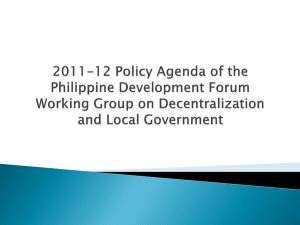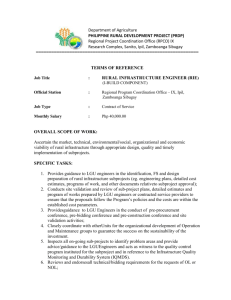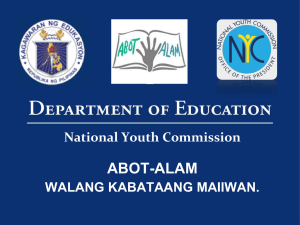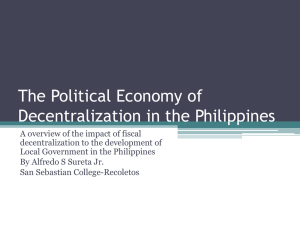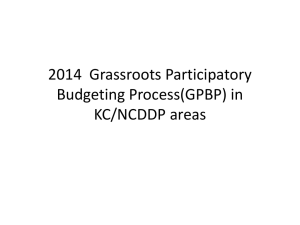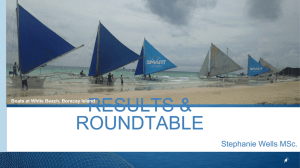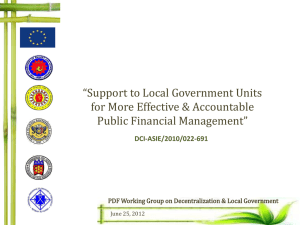2014 Extension and Capacity
advertisement
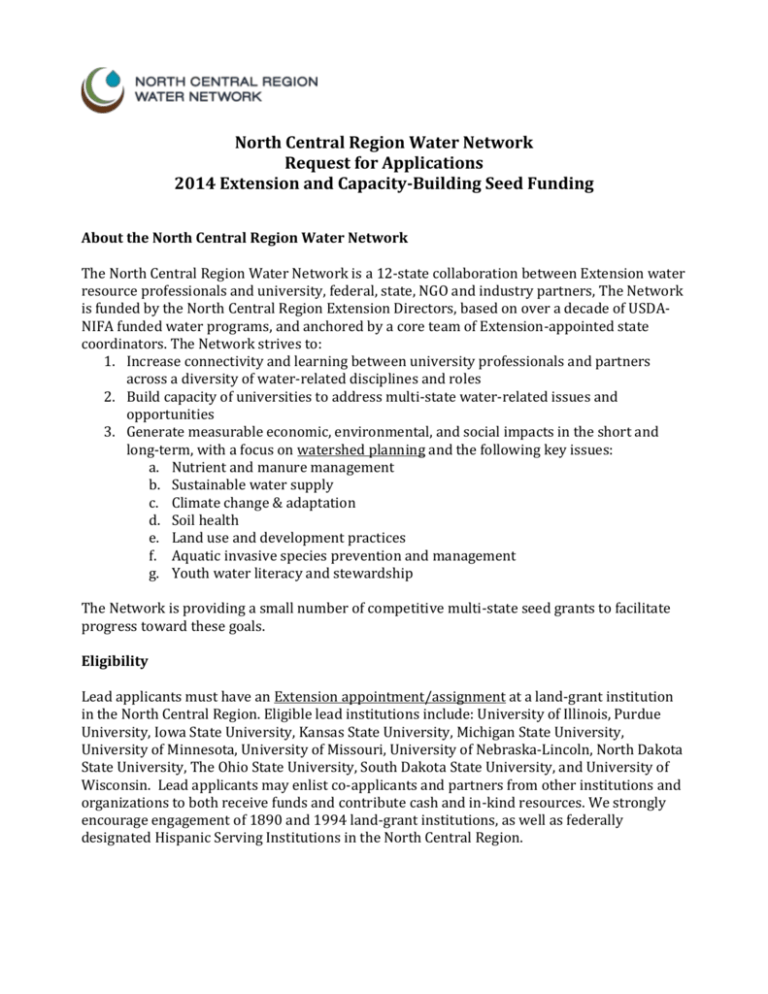
North Central Region Water Network Request for Applications 2014 Extension and Capacity-Building Seed Funding About the North Central Region Water Network The North Central Region Water Network is a 12-state collaboration between Extension water resource professionals and university, federal, state, NGO and industry partners, The Network is funded by the North Central Region Extension Directors, based on over a decade of USDANIFA funded water programs, and anchored by a core team of Extension-appointed state coordinators. The Network strives to: 1. Increase connectivity and learning between university professionals and partners across a diversity of water-related disciplines and roles 2. Build capacity of universities to address multi-state water-related issues and opportunities 3. Generate measurable economic, environmental, and social impacts in the short and long-term, with a focus on watershed planning and the following key issues: a. Nutrient and manure management b. Sustainable water supply c. Climate change & adaptation d. Soil health e. Land use and development practices f. Aquatic invasive species prevention and management g. Youth water literacy and stewardship The Network is providing a small number of competitive multi-state seed grants to facilitate progress toward these goals. Eligibility Lead applicants must have an Extension appointment/assignment at a land-grant institution in the North Central Region. Eligible lead institutions include: University of Illinois, Purdue University, Iowa State University, Kansas State University, Michigan State University, University of Minnesota, University of Missouri, University of Nebraska-Lincoln, North Dakota State University, The Ohio State University, South Dakota State University, and University of Wisconsin. Lead applicants may enlist co-applicants and partners from other institutions and organizations to both receive funds and contribute cash and in-kind resources. We strongly encourage engagement of 1890 and 1994 land-grant institutions, as well as federally designated Hispanic Serving Institutions in the North Central Region. Purpose of this Request for Applications and Award Size The purpose of this request for applications is to support the goals of the North Central Region Water Network. A maximum of $80,000 will be awarded, with each award being up to $30,000. It is anticipated that three to six awards will be made in 2014. All proposals must: 1. Include at least three states. 2. Address North Central Region Water Network goals, including one or more of the six key water-related issues listed above. 3. Show the potential to demonstrate and document transformative impact in waterrelated programming or Extension’s capacity to address water-related issues. Three types of proposals will be considered: 1. Planning Projects – The purpose of planning projects is to do one or more of the following: a. Prepare for competitive funding opportunities. b. Work with partners to plan Extension programs or related applied research that could be funded through contracts or other non-competitive funding mechanisms. c. Develop a plan for expanding a high quality Extension program to address needs of additional states in the North Central Region. 2. Program Delivery Projects – The purpose of program delivery projects is to conduct new multi-state Extension programming for which a plan for multi-state work already exists. 3. Professional Development for Extension Professionals to Improve Water-Related Extension Programs – A study sponsored by the Extension Committee on Organization and Policy (ECOP) identified key characteristics of 21st Century Extension professionals by reviewing Extension job postings, surveying Extension Directors/Administrators and conducting focus groups with outstanding Extension professionals. The purpose of these projects is to enhance skills of Extension professionals identified by the study’s Advisory Committee as “emerging” to address a specific water quality programming need. Please see Appendix A for the list of identified emerging skills and attributes. More information on the study can be found at: The Skills and Attributes of 21st Century Extension Professionals. Application Format and Contents Total application pages will not exceed 10. The cover letter, budget, and letters of support will not count against the 10-page limit. Font size must be at least 12 point, with margins of at least one inch in all directions and line spacing not exceeding six lines of text per vertical inch. 2 Contents should include: 1. Cover page a. Title b. Date c. Project director and co-directors d. Signatures and dates from Extension State Water Coordinators in participating states 2. Abstract (400 words or less) a. Problem/opportunity b. Beneficiary audience, approach and solution c. Deliverables and outcomes/impacts 3. Introduction a. Context b. Problem or opportunity 4. Response a. Beneficiary audiences b. Approach/methods c. Alignment with water-related plans and priorities such as: i. Mississippi River Gulf of Mexico Watershed Nutrient Task Force and state-level nutrient strategies ii. Great Lakes Restoration Initiative iii. The Red River Basin Commission iv. Groundwater conservation in the High Plains aquifer v. The APLU Natural Resources Roadmap 5. Project deliverables, timeline, outcomes/impacts, and how they relate to Network goals 6. Logic model or concept map that includes: a. Inputs b. Outputs c. Outcomes d. Clear relationship between outputs and outcomes For useful program planning and logic model information and templates, please see the University of Wisconsin-Extension Program Development and Evaluation resources. Moderate evaluation support will be provided to all successful applicants. 7. Partners and their roles, including engagement of the following if applicable to the project: a. Multi-state committees engaged in research and extension activities pertinent to the project. See Appendix B for a list of multi-state committees engaged in activities that are either directly or indirectly related to water resource management. If there are no pertinent committees, please indicate this. b. 1890 and1994 land-grant institutions. See Appendix C for a list of 1890 and 1994 land-grant institutions in the North Central Region. 8. Resource leveraging and sustainable funding: briefly describe resources leveraged. Planning and Program Delivery Projects must also describe plans for securing resources to continue work after seed funding ends. Proposals that document at least: 3 a 1:1 cash match, a 3:1 in-kind match, or a comparable combination of cash and in-kind match will be reviewed more favorably than projects that do not document match. Proposals that leverage non-Extension resources will be reviewed more favorably than those that rely solely on existing Extension funds (e.g. salary) as match. 9. Literature cited 10. Budget and narrative, including cash and in-kind match (see Appendix C for budget template). 11. Two or more letters of support from project partners and/or beneficiaries. Proposal Submission and Notification Please submit your applications no later than June 27, 2014, 5pm CST via e-mail to: 1. Rebecca Power: rlpower@wisc.edu 2. Martha Martin: mlmartin3@wisc.edu 3. Extension State Water Coordinators in participating states Your Extension State Water Coordinator’s signature must be on your application cover page. Use the budget template provided. If you choose to use another budget format, consult with the Regional Director (Rebecca Power, rlpower@wisc.edu) prior to submitting. Submit all application components, including budget and letters of support, in a single pdf file named: Projectdirectorlastname_firstname_year.pdf (e.g. smith_jane_2014.pdf) Applicants will be notified of review results no later than July 25, 2014. The allowed project period will be from the time successful applicants are notified through August 30, 2015. Funds Disbursement Successful applicants will request funds through invoices to the University of WisconsinExtension. Lead applicants will send invoices to Rebecca Power, North Central Region Water Network. Successful applications will not result in a formal contract or grant. Funds should be housed in a segregated account and are to be spent in accordance with federal guidelines for Smith Lever-formula funds and within the scope of the accepted budget. General purpose equipment, tuition reimbursement, and indirect costs are not allowed. More instructions will be shared when successful lead applicants are notified. 4 Review Criteria The following criteria will be used by reviewers to evaluate and select applications for funding. Criteria will be applied as appropriate to the type of application (Planning, Programming, or Professional Development). 1. To what extent will the project address one or more of the following key issues, either as stand-alone issues or though watershed planning: a. Nutrient and manure management b. Sustainable water supply c. Climate change & adaptation to handle both flooding and drought situations d. Soil health e. Land use and development practices f. Aquatic invasive species prevention and management g. Youth water literacy and stewardship 2. To what extent will the project support or integrate with existing multi-state plans and priorities, such as those associated with: Mississippi River Gulf of Mexico Watershed Nutrient Task Force and statelevel nutrient strategies Great Lakes Restoration Initiative The Red River Basin Commission Groundwater conservation in the High Plains aquifer The APLU Natural Resources Roadmap 3. To what extent will the project increase multi-state connectivity and learning among university professionals and partners? 4. To what extent will the project strengthen existing or create new collaborations between university researchers and extension educators? 5. To what extent will the project build capacity of universities to address multi-state water-related issues and opportunities, including: Expanding successful extension programs to additional states Generating new funding for extension programming through competitive grants, contracts for services, or fee-based programs? 4. To what extent will the project leverage institutional and financial resources outside of the university in the short and long term? Proposals that document at least: a 1:1 cash match, a 3:1 in-kind match, or a comparable combination of cash and in-kind match will be reviewed more favorably than projects that do not document match. Proposals that leverage non-Extension resources will be reviewed more favorably than those that rely solely on existing Extension funds (e.g. salary) as match. 6. To what extent will the project generate measurable economic, environmental, and social impacts in the short and long-term? Special consideration will be given to projects that have the potential for transformative impact on water-related programming or Extension’s capacity to address water-related issues. 5 Appendix A Selected Emerging Skills and Attributes of 21st Century Extension Professionals* 1. Conduct robust needs assessments (engage stakeholders), focus on key emerging issues, prioritize and align programming. a. Engage audiences representing emerging demographics, strengthen our cultural competency. 2. Strengthen engagement with learners and partners to facilitate co-learning and codiscovery of new knowledge. a. Develop high-level facilitation and conflict resolution skills. b. Creative problem-solving strategies or processes. 3. Define and pursue Extension scholarship. a. Develop innovative, engaging learning experiences using a variety of methodologies including technology b. Evaluate innovative learning methodologies and assess effectiveness with current and new audiences. c. Conduct applied, translational research to facilitate knowledge transfer. d. Impact assessment 4. Develop and apply innovative resource generation strategies (beyond grants and fee revenue). 5. Improve marketing, public relations, branding, and public value skills. 6. High emotional intelligence and collaboration skills. * More information on the study can be found at: The Skills and Attributes of 21st Century Extension Professionals. 6 Appendix B Multistate Research Projects and Committees Applicable to North Central Region Water Activities Organized by Region Projects are organized into 2 main categories: Direct and Indirect. Direct projects directly relate to water management and issues in the projects focus. The indirect classification means water is not the center issue at study but that water impacts are part of the study in some aspect either large or small. List of committee types and abbreviations: Committee Types Abbreviation Multi-state Research Coordinating Committee Development Committee Extension and Research Activity NC, NE, S, or W only CC DC ERA Projects that directly apply to water management organized by region: Project Number Title Link to Participants Directory NC1182 Nitrogen Cycling, Loading, and Use Efficiency in Forage-Based Livestock Production Systems (formerly NCT196 and NC-189) Water Management and Quality for Ornamental Crop Productions and Health The Chemical and Physical Nature of Particulate Matter Affecting Air, Water and Soil Quality (NCR174) Understanding the Ecological and Social Constraints to Achieving Sustainable Fisheries Resource Policy and Management Catalysts for Water Resources Protection and Restoration: Applied Social Science Research Drainage design and management practices to improve water quality North Central (NC) NC1186 NC1187 NC1189 NC1190 NCERA217 http://lgu.umd.edu/lgu_v2/homepages/member.cfm?trackID=10916 http://lgu.umd.edu/lgu_v2/homepages/member.cfm?trackID=12296 http://lgu.umd.edu/lgu_v2/homepages/member.cfm?trackID=12136 http://lgu.umd.edu/lgu_v2/homepages/member.cfm?trackID=13136 http://lgu.umd.edu/lgu_v2/homepages/home.cfm?trackID=13236 http://lgu.umd.edu/lgu_v2/homepages/member.cfm?trackID=11396 Northeast (NE) NE1038 NE1045 NE1438 Hydropedology: Genesis, Properties, and Distribution of Hydromorphic Soils Design, Assessment, and Management of Onsite Wastewater Treatment Systems: Addressing the Challenges of Climate Change Hydropedology of Vernal Pool Systems http://lgu.umd.edu/lgu_v2/homepages/member.cfm?trackID=11436 http://lgu.umd.edu/lgu_v2/homepages/member.cfm?trackID=12376 http://lgu.umd.edu/lgu_v2/homepages/member.cfm?trackID=16317 7 South (S) SDC358 SERA006 SERA043 Quantification of best management practice effectiveness for water quality protection at the watershed scale Methodology, Interpretation, and Implementation of Soil, Plant, Byproduct, and Water Analyses Southern Region Integrated Water Resources Coordinating Committee http://lgu.umd.edu/lgu_v2/homepages/member.cfm?trackID=16016 Micro-irrigation for sustainable water use Soil-Based Use of Residuals, Wastewater and Reclaimed Water Water Policy and Management Challenges in the West Nutrient Management and Water Quality Managing and Utilizing Precipitation Observations from Volunteer Networks Western Region Multistate Coordinating Committee on Water Resources Meteorological and Climate Data to Support ET-Based Irrigation Scheduling, Water Conservation, and Water Resources Management (from WDC18) Scaling Micro-irrigation Technologies to Address the Global Water Challenge Beneficial Reuse of Residuals and Reclaimed Water: Impact on Soil Ecosystem and Human Health (formerly W2170) Soil, Water, and Environmental Physics Across Scales Management and Policy Challenges in a Water-Scarce World http://lgu.umd.edu/lgu_v2/homepages/member.cfm?trackID=11236 http://lgu.umd.edu/lgu_v2/homepages/member.cfm?trackID=14556 http://lgu.umd.edu/lgu_v2/homepages/member.cfm?trackID=15676 WEST (W) W2128 W2170 W2190 WERA103 WERA1012 WERA1020 WERA1022 W_TEMP3128 W_TEMP3170 W_TEMP3188 W_TEMP3190 http://lgu.umd.edu/lgu_v2/homepages/member.cfm?trackID=10996 http://lgu.umd.edu/lgu_v2/homepages/member.cfm?trackID=11237 http://lgu.umd.edu/lgu_v2/homepages/member.cfm?trackID=12156 http://lgu.umd.edu/lgu_v2/homepages/member.cfm?trackID=15498 http://lgu.umd.edu/lgu_v2/homepages/member.cfm?trackID=14536 http://lgu.umd.edu/lgu_v2/homepages/member.cfm?trackID=13976 http://lgu.umd.edu/lgu_v2/homepages/member.cfm?trackID=16476 http://lgu.umd.edu/lgu_v2/homepages/member.cfm?trackID=15936 http://lgu.umd.edu/lgu_v2/homepages/member.cfm?trackID=16636 http://lgu.umd.edu/lgu_v2/homepages/member.cfm?trackID=16396 8 Projects that indirectly apply to water management organized by region: Project Number Title Link to Participants Directory NC1034 Impact Analyses and Decision Strategies for Agricultural Research Impacts of Crop Residue Removal for Biofuel on Soils (formerly NC1017) Food, Feed, Fuel, and Fiber: Security Under a Changing Climate Enhancing nitrogen utilization in corn based cropping systems to increase yield, improve profitability and minimize environmental impacts (NC1032/210) Cover crops to improve environmental quality in crop and biofuel production systems in the Great Lakes and Upper Mississippi basins Soil Testing and Plant Analysis Soil Organic Matter: Formation, Function and Management Precision Agriculture Technologies for Food, Fiber, and Energy Production Turfgrass and the Environment (was NCERA192) Soil and Landscape Assessment, Function and Interpretation North Central (NC) NC1178 NC1179 NC1195 NCCC211 NCERA013 NCERA059 NCERA180 NCERA221 NCERA_TEMP003 http://lgu.umd.edu/lgu_v2/homepages/member.cfm?trackID=13317 http://lgu.umd.edu/lgu_v2/homepages/member.cfm?trackID=11016 http://lgu.umd.edu/lgu_v2/homepages/member.cfm?trackID=10917 http://lgu.umd.edu/lgu_v2/homepages/member.cfm?trackID=12896 http://lgu.umd.edu/lgu_v2/homepages/member.cfm?trackID=12236 http://lgu.umd.edu/lgu_v2/homepages/member.cfm?trackID=13276 http://lgu.umd.edu/lgu_v2/homepages/member.cfm?trackID=13316 http://lgu.umd.edu/lgu_v2/homepages/member.cfm?trackID=13196 http://lgu.umd.edu/lgu_v2/homepages/member.cfm?trackID=13837 http://lgu.umd.edu/lgu_v2/homepages/member.cfm?trackID=15996 9 Northeast (NE) NE1010 NE1041 NE1044 NE1046 NE1049 NE1335 NECC1013 NECC1312 NEERA1002 NE_TEMP2144 NRSP003 Breeding and Genetics of Forage Crops to Improve Productivity, Quality, and Industrial Uses Environmental Impacts of Equine Operations Whole farm dairy and beef systems: gaseous emissions, P management, organic production, and pasture based production Management of Annual Bluegrass on Golf Courses: Improved Practices for Maintenance, Pest Control, and Viable Techniques for Transition to More Desirable Grasses Community Health and Resilience Resource Management in Commercial Greenhouse Production Strategies to Evaluate and Mitigate Ozone Impacts on the Structure and Function of Vegetation Northeast Coordinating Committee on Soil Testing Adaptive Management for Improved Nutrient Management Poultry Production Systems and Wellbeing: Sustainability for Tomorrow The National Atmospheric Deposition Program (NADP) http://lgu.umd.edu/lgu_v2/homepages/member.cfm?trackID=1314 http://lgu.umd.edu/lgu_v2/homepages/member.cfm?trackID=11196 http://lgu.umd.edu/lgu_v2/homepages/member.cfm?trackID=12116 http://lgu.umd.edu/lgu_v2/homepages/member.cfm?trackID=12876 http://lgu.umd.edu/lgu_v2/homepages/member.cfm?trackID=13996 http://lgu.umd.edu/lgu_v2/homepages/member.cfm?trackID=15416 http://lgu.umd.edu/lgu_v2/homepages/member.cfm?trackID=13736 http://lgu.umd.edu/lgu_v2/homepages/member.cfm?trackID=15896 http://lgu.umd.edu/lgu_v2/homepages/member.cfm?trackID=11316 http://lgu.umd.edu/lgu_v2/homepages/member.cfm?trackID=15899 http://lgu.umd.edu/lgu_v2/homepages/member.cfm?trackID=10416 South (S) S1032 S1048 Animal Production Systems: Synthesis of Methods to Determine Triple Bottom Line Sustainability from Findings of Reductionist Research Assessment of the Carbon Sequestration http://lgu.umd.edu/lgu_v2/homepages/member.cfm?trackID=15636 http://lgu.umd.edu/lgu_v2/homepages/member.cfm?trackID=11096 10 S1054 S1055 SCC083 SERA017 SERA020 SERA025 SERA042 Potential of Common Agricultural Systems on Benchmark Soils Across the Southern Region Climate Gradient Bio-based Fibrous Materials and Cleaner Technologies for a Sustainable and Environmentally Responsible Textile Industry Biology, impact, and management of soybean insect pests in soybean production systems Quantifying the Linkages Among Soil Health, Organic Farming, and Food Organization to Minimize Nutrient Loss from the Landscape Southern Conservation Tillage Systems Conference Turf (IEG-16) Enhancement of Leadership Capacity to Address Global Issues in the Food Systems through Coalition Development http://lgu.umd.edu/lgu_v2/homepages/member.cfm?trackID=14296 http://lgu.umd.edu/lgu_v2/homepages/member.cfm?trackID=14636 http://lgu.umd.edu/lgu_v2/homepages/member.cfm?trackID=12576 http://lgu.umd.edu/lgu_v2/homepages/member.cfm?trackID=15716 http://lgu.umd.edu/lgu_v2/homepages/member.cfm?trackID=11876 http://lgu.umd.edu/lgu_v2/homepages/member.cfm?trackID=15836 http://lgu.umd.edu/lgu_v2/homepages/member.cfm?trackID=14896 WEST (W) W1012 W2004 W2045 W2082 W2188 Improving ruminant use of forages in sustainable production systems for the western U.S. Marketing, Trade, and Management of Aquaculture and Fishery Resources AGROCHEMICAL IMPACTS ON HUMAN AND ENVIRONMENTAL HEALTH: MECHANISMS AND MITIGATION Evaluating the Physical and Biological Availability of Pesticides and Contaminants in Agricultural Ecosystems Characterizing Mass and Energy Transport http://lgu.umd.edu/lgu_v2/homepages/member.cfm?trackID=11816 http://lgu.umd.edu/lgu_v2/homepages/member.cfm?trackID=11456 http://lgu.umd.edu/lgu_v2/homepages/member.cfm?trackID=12596 http://lgu.umd.edu/lgu_v2/homepages/member.cfm?trackID=12276 http://lgu.umd.edu/lgu_v2/homepages/member.cfm?trackID=11596 11 W3133 W3147 W3185 WCC1008 WERA011 WERA027 WERA102 WERA1008 WERA1014 WERA1018 at Different Vadose Zone Scales Benefits and Costs of Natural Resources Policies Affecting Ecosystem Services on Public and Private Lands Managing Plant Microbe Interactions in Soil to Promote Sustainable Agriculture Biological Control in Pest Management Systems of Plants Rangeland Education Across Institutional Borders Western Regional Turfgrass Research Potato Variety Development Climate Data and Analyses for Applications in Agriculture and Natural Resources Rangelands West Partnership Intensive Pasture Management for Sustainable Livestock Production in the Western US The Social-Ecological Resilience of Rangelands in Working Landscapes http://lgu.umd.edu/lgu_v2/homepages/member.cfm?trackID=14376 http://lgu.umd.edu/lgu_v2/homepages/member.cfm?trackID=14876 http://lgu.umd.edu/lgu_v2/homepages/member.cfm?trackID=14316 http://lgu.umd.edu/lgu_v2/homepages/member.cfm?trackID=15396 http://lgu.umd.edu/lgu_v2/homepages/member.cfm?trackID=13596 http://lgu.umd.edu/lgu_v2/homepages/member.cfm?trackID=12256 http://lgu.umd.edu/lgu_v2/homepages/member.cfm?trackID=12536 http://lgu.umd.edu/lgu_v2/homepages/member.cfm?trackID=13016 http://lgu.umd.edu/lgu_v2/homepages/member.cfm?trackID=15556 http://lgu.umd.edu/lgu_v2/homepages/member.cfm?trackID=14616 12 Appendix C 1890 and 1994 Land-grant Institutions in the North Central Region 1890 Institutions Lincoln University, Jefferson City, MO Central State University, Wilberforce, OH 1994 Institutions Bay Mills Community College, Brimley, MI Cankdeska Cikana Community College, Fort Totten, ND College of Menominee Nation, Keshena, WI Fond du Lac Tribal and Community College, Cloquet, MN Fort Berthold Community College, New Town, ND Haskell Indian Nations University, Lawrence, KS Keweenaw Bay Ojibwa Community College, Baraga, MI Lac Courte Oreilles Ojibwa Community College, Hayward, WI Leech Lake Tribal College, Cass Lake, MN Little Priest Tribal College, Winnebago, NE Nebraska Indian Community College, Macy, NE Oglala Lakota College, Kyle, SD Saginaw Chippewa Tribal College, Mt. Pleasant, MI Sinte Gleska University, Mission, SD Sisseton Wahpeton Community College, Agency Village, SD Sitting Bull College, Fort Yates, ND Turtle Mountain Community College, Belcourt, ND United Tribes Technical College, Bismarck, ND White Earth Tribal and Community College, Mahnomen, MN 13 Appendix D North Central Region Water Network Budget Template To access the budget template, please see: http://northcentralwater.org/?p=2131 14

